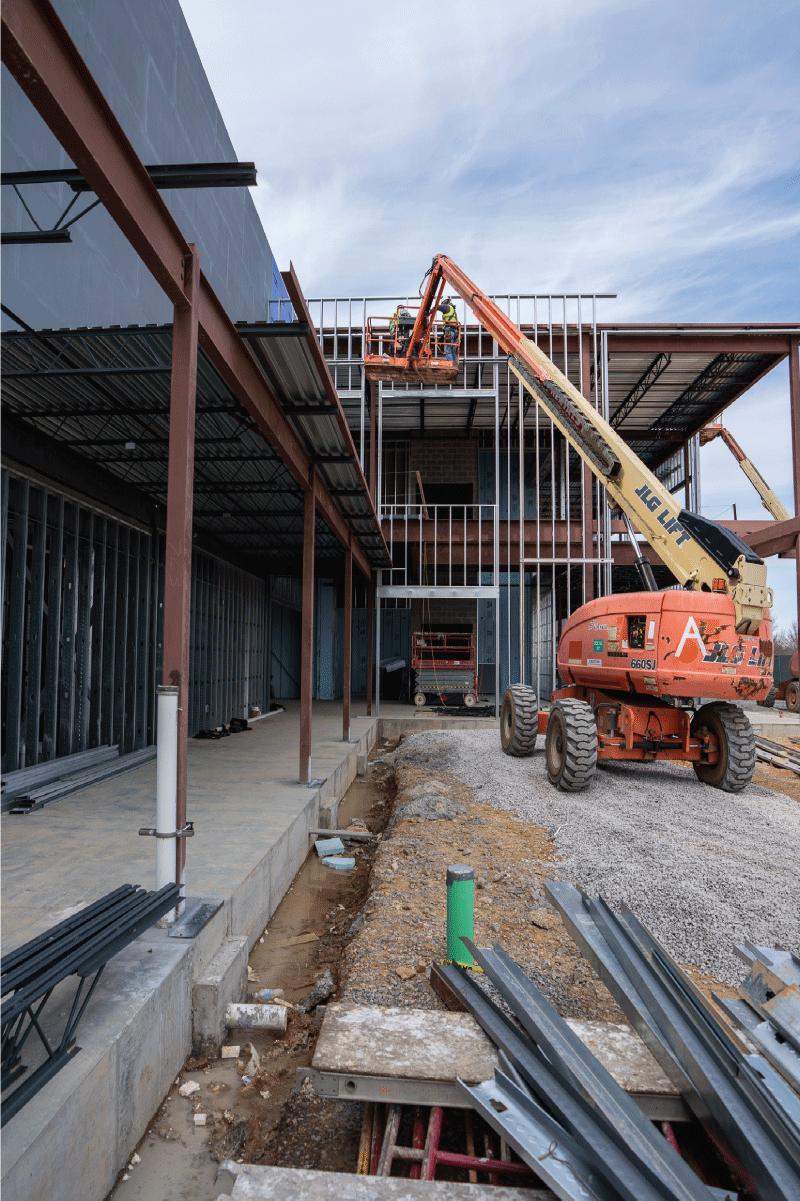Multiply. It’s what churches with multisite strategies seek to do. But to be successful, campus pastors and church leaders must learn how to maximize every square foot of their campuses.
What follows are five moves that designers use to help churches achieve a maximized scenario and make their campuses more viable and sustainable in the process.
Visioneering Studios’ vice president of strategic design, Dave Milam, sat down with Dr. David Fletcher, founder of XPastor in Austin, Texas, in a webinar from XPastor on August, 2023. This is a break-down of the wisdom that surfaced.
1. Identify the campus MVP and stick to it
MVP stands for Minimum Viable Product, or as Milam frames it: what’s the minimum space a given church campus needs to do church well? For example, what’s the minimum for quality worship space, quality kids’ space square footage, and lobby space.
- Does your site really need a kitchen, or will catering suffice?
- Do you need office space or can you figure out another way to “office” your staff?
- How many seats does your worship space require? Find the answer with this equation: total adults x 0.60 = number of seats. Remember, you can have multiple services if required over time.
- Bottom line for multisites: maximize your building and leverage every square foot.
- To determine the total square footage your site needs (or MVP SF), use this equation: number of seats x +/- 36sf (calculation for worship, kids and lobby spaces).
- Want a café? Consider putting one in the lobby.
- To determine MVP for parking and acreage and you’re going to get land and build from the ground up, use this method: plan for one acre of buildable land for every 100 seats you want long-term in the property.
- If you’re going to purchase an old AMC theater or Lifetime Fitness, for instance, keep your eye on a 2;1 parking to seat ratio for the site, or two seats for every one parking spot.
- Note: your city may actually require 3:1.
2. Land a new campus location
Here are four types of multisite locations to consider, from most expensive to least expensive:
- ground-up construction (parking, utilities, site work and building)—The most expensive option, especially when going onto a greenfield site where there’s nothing, Keep in mind: while you may be able to build a building for $300/square foot, you also have to build parking, bring the sewer line and electric to the site, do the sidewalks that the city requires, etc. And this added infrastructure can potentially increase the cost by 50%-100%.
- conversion renovation (adapting a building that was originally built for something other than church)—A church choosing this scenario must be careful for issues like, is there enough power in the building, the building’s zoning may not have allowed for assembly meeting space, and other concerns. The presence of adequate parking is critical in conversion renovation projects.
- facility adoption (the least expensive option – when a church decides to donate its building to another church)—This space is already set up for church, and there’s probably parking, so the site may only need a refresh, such as chairs, lighting, that can make a big difference. When inheriting a church as your site, make sure you do enough of a refresh that people can tell something has changed, and that your presence is a new situation for the building (read: you don’t want to look like the Chinese restaurant that took over the Pizza Hut).
- long-term lease (sometimes tenant improvement dollars are included in monthly rent)—While definitely an option, once the lease is up you have nothing to show for your investment.
3. Completely eradicate Hot Iron Syndrome whenever it appears
If you don’t know what this is, after considering it you’re going to start recognizing it all around you in the church world.
- The mentality behind Hot Iron Syndrome is that the campus renovations or build are one-and-done for a campus pastor, ““I have to strike while the iron is hot,” and there will never be another opportunity.
- The Hot Iron Syndrome is the cause of nearly every blown budget.
- If left unchecked, Hot Iron Syndrome can double the cost of a project.
- Work with a design and construction team who can smack the hands of people when a campus project is going over-budget.
4. Expand headroom and hardwire momentum into your plan
Here are two competing strategies: Site plan completion in one phase (price tag of $15 million to $18 million) vs. MVP phased approach (price tag of $3 million to $7 million). Consider, which one makes the most sense for a multisite?
- If a budget is $18 million and the whole plan is built in one phase, at the main site, that leaves multisite pastors waiting in the wings.
- Another strategy is to take that same $18 million and build three MVP campuses—and then feed the one that grows.
- You can build momentum by the power of what’s incomplete, which is momentum strategy, and this approach leaves headroom to grow.
- If a church tries to build everything all at once, the momentum is broken.
- Think of your multisite strategy as a rocket, with multi stages of momentum.*
- When momentum is hardwired into a church’s plans, an excellent campus strategy is the result.
5. Favor square footage quality over square footage quantity
Oftentimes, there’s a sweet spot of square footage that results in a truly impactful and well designed campus.
-
If the sweet spot is exceeded, a site’s finishes, furnishings and overall design suffer.
- It’s wise to strike a balance with lower square footage but higher quality.
- A special note for portable churches: on average, you will grind through your entire group of people every three years. But if a campus is in a 24/7 space, the turnover becomes approximately every seven years.
- Just by being in a space, you end up holding onto your people a little longer.
The takeaway
When thinking about a campus strategy, it is absolutely critical to define the minimum viable product (MVP) for a given campus. Then, the more successfully church staff holds fast to that MVP, the more quickly and successfully they will grow. And next? Feed what grows.
Watch the full webinar here
5 Make-or-Break Campus Design and Renovation Strategies
Lorem Ipsum dolor sit amet quid dolormentum. Proin gravida nibh vel velit auctor aliquet. Aenean sollicitudin, lorem quis bibendum auctorelit consequat ipsum, nec sagittis sem nibh id elit. Duis sed odio sit amet nibh vulputate cursus a sit amet mauris. Morbi accumsan ipsum velit. Nam nec tellus a odio tincidunt auctor a ornare odio. Sed non mauris vitae erat consequat auctor eu in elit. Class aptent taciti sociosqu ad litora torquent per conubia nostra per inceptos himenaeos. Mauris in erat
10 Church Design Lessons From a Disney Imagineer
Lorem Ipsum dolor sit amet quid dolormentum. Proin gravida nibh vel velit auctor aliquet. Aenean sollicitudin, lorem quis bibendum auctorelit consequat ipsum, nec sagittis sem nibh id elit. Duis sed odio sit amet nibh vulputate cursus a sit amet mauris. Morbi accumsan ipsum velit. Nam nec tellus a odio tincidunt auctor a ornare odio. Sed non mauris vitae erat consequat auctor eu in elit. Class aptent taciti sociosqu ad litora torquent per conubia nostra per inceptos himenaeos. Mauris in erat


